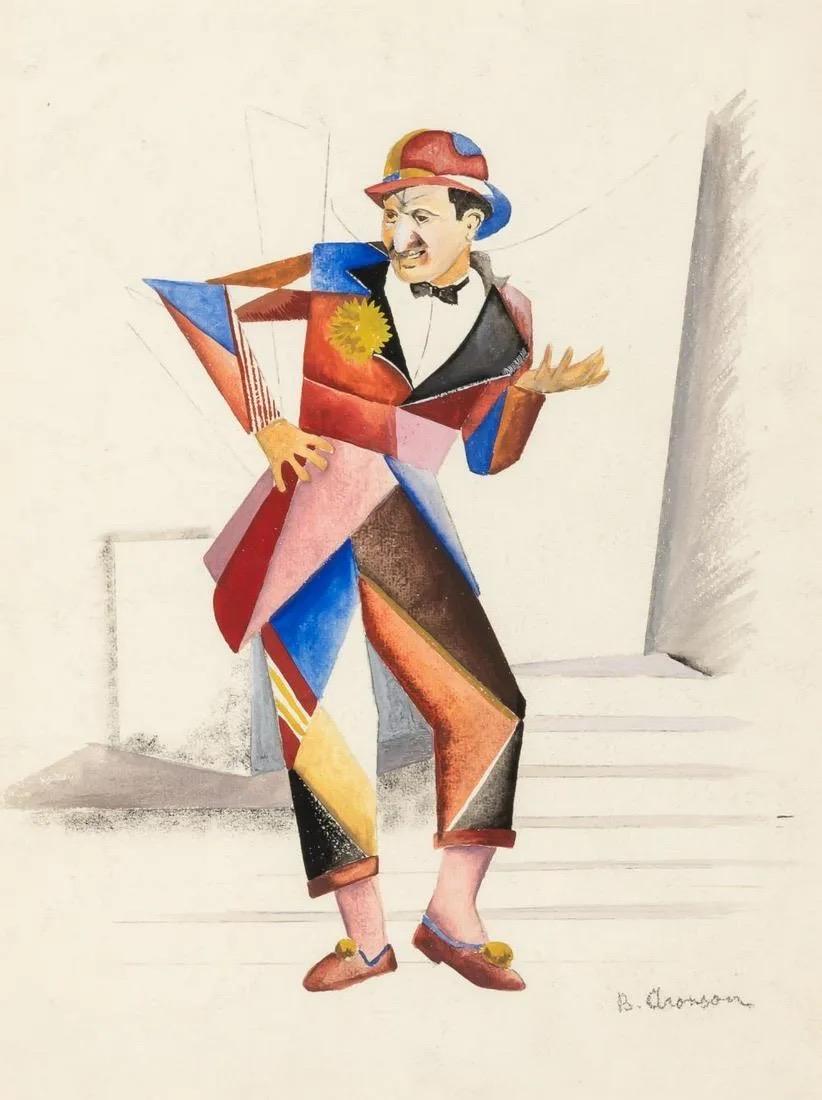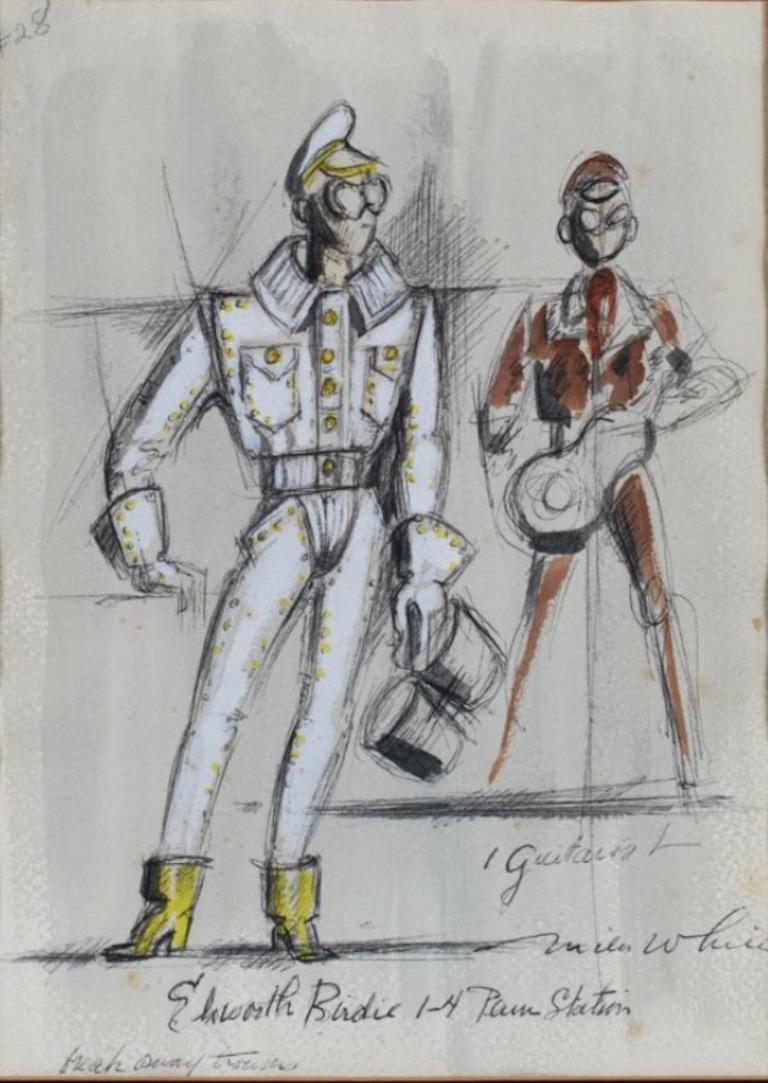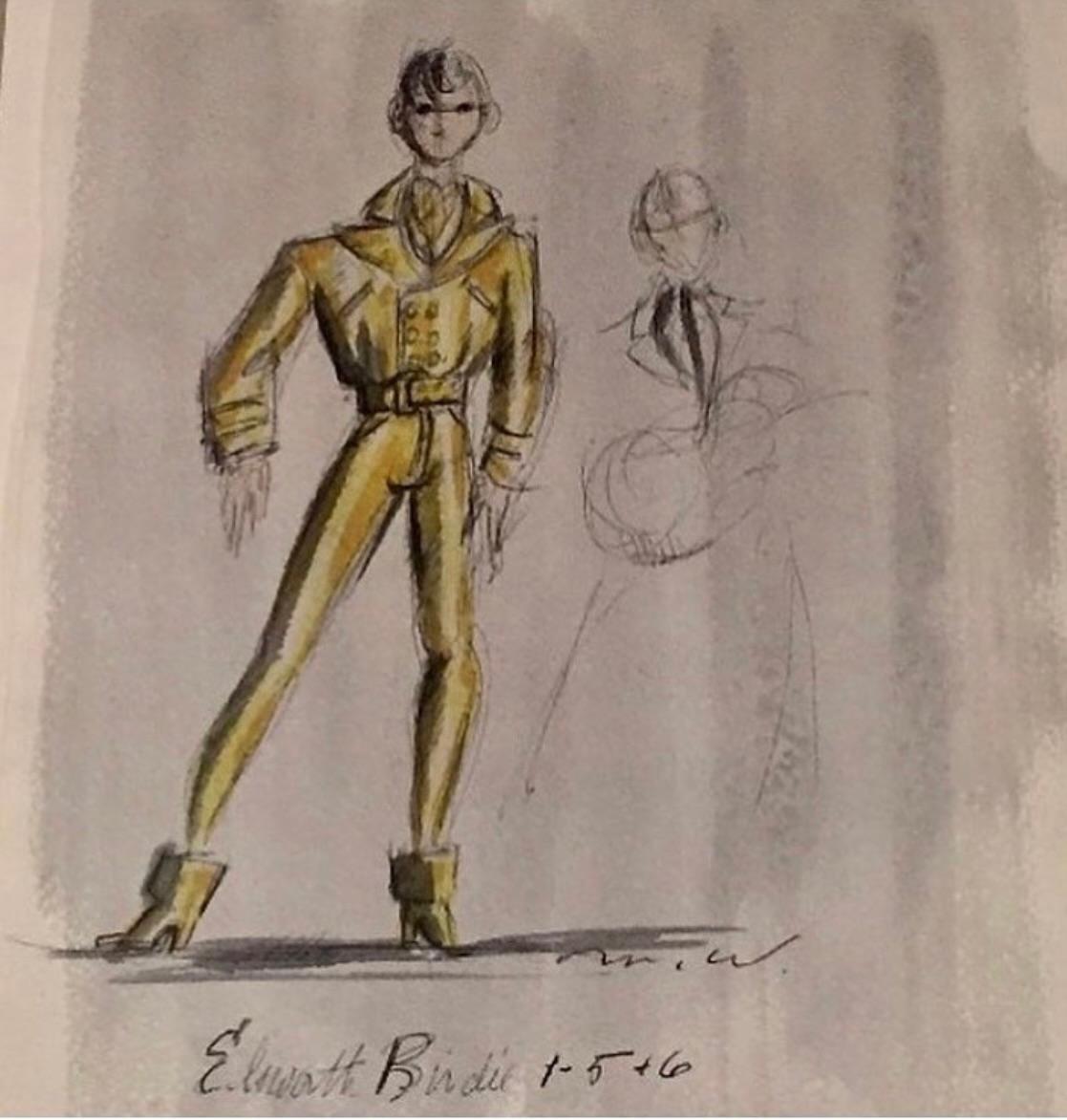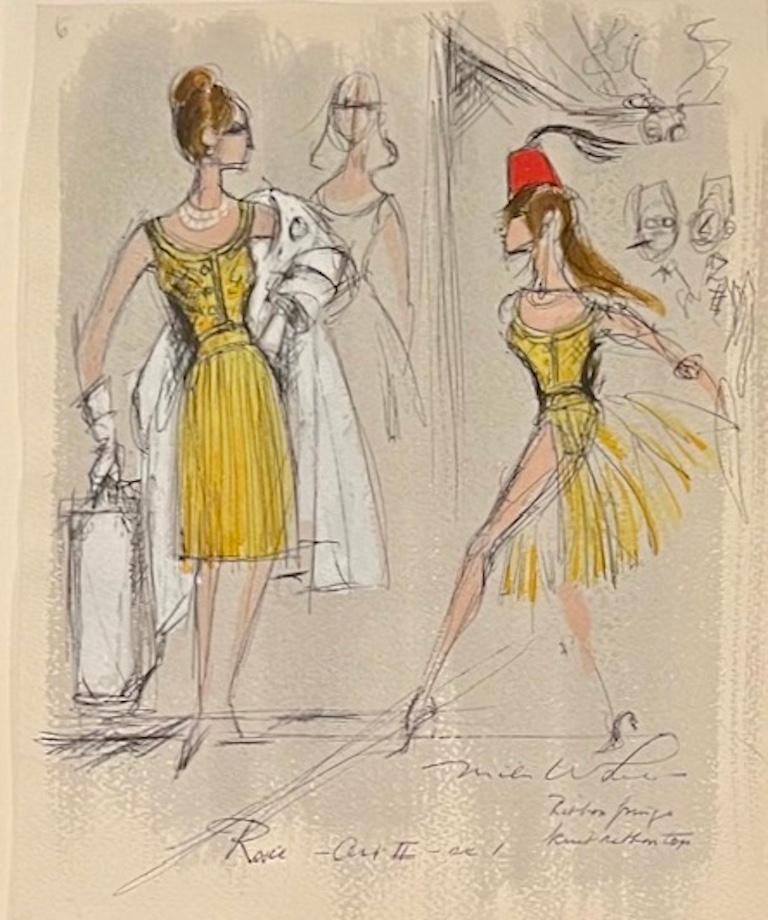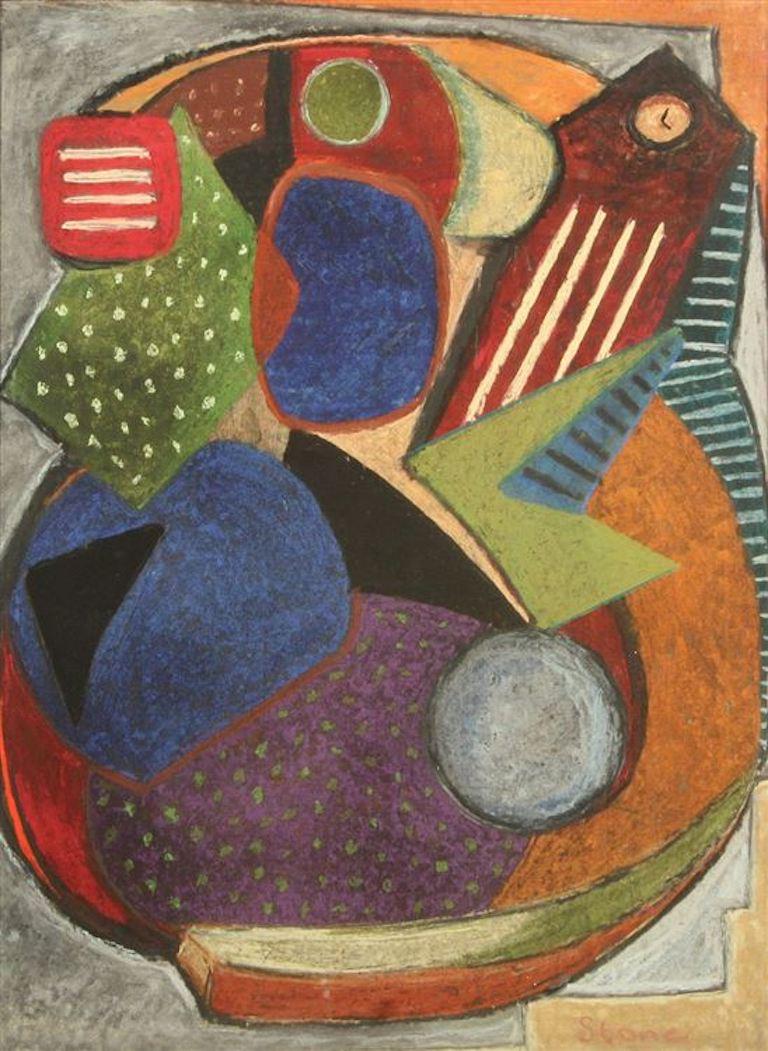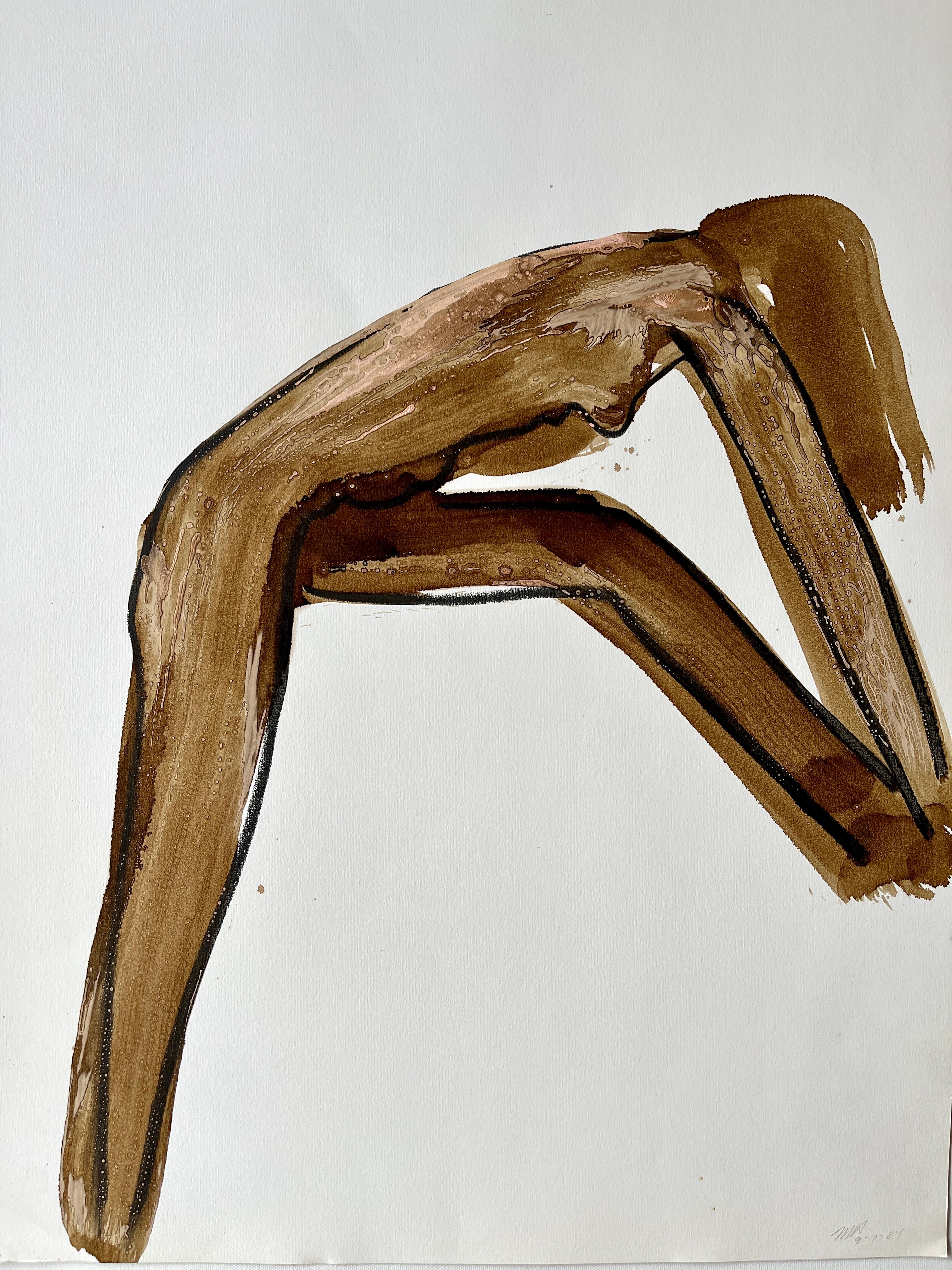Items Similar to SURREALIST LANDSCAPE
Want more images or videos?
Request additional images or videos from the seller
1 of 6
Edward HagedornSURREALIST LANDSCAPE
About the Item
EDWARD HAGEDORN (AMERICAN 1902 – 1982)
SURREAL LANDSCAPE 1931 mixed media on paper, Graphite, ink and watercolor. Unsigned. Dtaed 2/26/31, in ink lower left margin. Image 13 3/4 x 16 1/2 inches. On a large sheet 20 x 25 inches.
Provenance: Hagedorn estate, Around the mid 1980's The Hagedorn estate was dispersed in Berkeley by a local dealer. This drawing was part of a group of Hagedorn works on paper that I acquired from that dispersal. Much of the balance was later acquired the Struart Denenberg Fine Art.
Denenberg published a very fine book on the artist's work.
EDWARD HAGEDORN: CALIFORNIA MODERNIST, RESTLESSNESS AND RESTRAINT Hardcover – January 1, 2009
Subsequently Hagedorn's works on paper have been acquired by many museums and some accompanying exhibitions.
ALL OF THE COMMENTS BELOW ARE FROM THE FOLLOWING EXHIBITION
EDWARD HAGEDORN (1902-1982)
American Modernist
A New Traveling Exhibition
“VOLCANOS, WRECKS, RIOTS, & NUDES”, EDWARD HAGEDORN (1902-1982)
premiere at the Danforth Museum. Framingham, MA, in March 2016. The exhibition includes 75 works of art in various mediums and is accompanied by the first monograph devoted to the artist’s work with essays by leading curators, critics, and art historians.
Edward Hagedorn was a true Modernist who created a trove of powerful works on paper--drawings, watercolors, oils, and original graphics that reveal the hand of a master draftsman and the mind of an astute political observer. He rejected the general trend in early 20th century California of local landscapes and coastal views, becoming virtually the single voice of Expressionism. He conveyed the darkness and upheaval that gripped the country in the depression years between the two World Wars, 1925- 1935, more forcefully than any of his contemporaries, influenced by German art of the time, engaging in modernist styles of Expressionism and Surrealism.
Hagedorn’s skeletons are ferocious yet somehow endearing; printed in deep black ink on off-white paper, they march across Lilliputian landscapes of grim disorder and destruction. Comets and volcanoes explode in fauvist colors, their other-worldly fluorescent temperas framed in black, while nude female figures, executed in exquisitely refined pen and ink, or graphite line drawings, are as economical in their means as Matisse, and can be compared with the neo-classical drawings of Picasso. Among his most lyrical works of the 1920s is a series of rhythmically abstracted watercolor and ink views of Golden Gate Park, evoking the sensual demi-geometries of Balthus, Derain , and early Mondrian.
American Modernist Edward Hagedorn (1902-1982) was born in San Francisco of German descent; his mother (née Kafka) died in childbirth, and he was legally adopted and raised by his grandmother and aunt. After attendance at the San Francisco School of Fine Arts in the early 1920s, by age 22 he had a studio in the famed "100" block of Montgomery Street ("the Monkey Block,") then a haven for bohemians.
In 1926, a year of tremendous importance in California artists' embrace of modern art, the Oakland Art Gallery, with the guidance and inspiration of their European representative Emmy (Galka) Scheyer, was the first museum in the United States to show the art of the "Blue Four," among the leading artists of International Modernism--Paul Klee, Lyonel Feininger, Alexei Jawlensky, and Wassily Kandinsky.
The overwhelming influences in Scheyer's exhibitions in Oakland and later in Pasadena, were German art movements. She appreciated the abstractionist teaching of Hans Hoffman, who later taught at the University of California, Berkeley, and his Munich students, as well as the increasing importance of Bauhaus, Dada, and Surrealist aesthetics. Hagedorn, of German extraction, was drawn to these influences. Scheyer offered to represent his work, inviting the young artist to become the fifth member of her distinguished group. He rejected her overtures. Scheyer's group of Hagedorn drawings was left to the the Norton Simon Museum, together with her important collection of works by the Blue Four, and major examples by Dix, Kirchner, Kokoschka, Leger, Lissitsky, Nolde, Schwitters, Schlemmer, and Picasso.
"Ed was an outsider, a loner, a tall thin man who walked down the street looking like a question-mark; he had no use for success," according to fellow artist Paul Carey. Financially independent from the 1930's on, having inherited a sizable income from his maternal family's insurance agency, Hagedorn made little effort to market his art, but continued to work prodigiously in the seclusion of his studio/residence in Berkeley, and was active in bohemian North Beach, San Francisco, a friend and illustrator of writer Kenneth Rexroth and poet Czeslaw Milosz.
Oakland Museum Director William Clapp was intellectually open to the entire spectrum of modernism, and in 1927 included Hagedorn's painting of a female nude wearing nothing but silk stockings. It created a scandal reminiscent of the first exhibition of Courbet's 1866 oil, "Origin of the World," or recently Robert Mapplethorpe's explicit photographs. Then critic for The Chronicle, Gene Hailey, together with a "lady's committee" demanded the painting's withdrawal in newspaper articles and in letters to Director Clapp who steadfastly supported freedom of expression. Despite attempts at censorship and disinheritance by his wealthy father, Hagedorn persisted in his convictions, and refused to withdraw the work; he continued to depict the female nude throughout his long life.
Edward Hagedorn achieved critical national acclaim exhibiting widely, and winning print competitions at the De Young Museum, the Brooklyn Museum, and the Pennsylvania Academy of Fine Art, participating as well in the Works Progress Administration (the WPA.) In the 1960s, eminent San Francisco Chronicle critic Alfred Frankenstein stated, "Hagedorn is one of the finest draughtsman I ever knew."
Some public collections holding Hagedorn's work include the Norton Simon Museum; Chicago Art Institute; National Museum of American Art, Achenbach Foundation for Graphic Art, San Francisco; Carnegie Art Institute, the Huntington Museum; Oakland Museum of Art; the National Museum of American Art, Smithsonian Instituion; Library of Congress; Whitney Museum of American Art; Getty Center; and the Fitzwilliam Museum, Cambridge, England.
Edward Hagedorn's art is a major discovery in American Modernism. He conveyed more forcefully than most of his contemporaries the darkness and upheaval that gripped the country in the years between the two World Wars and during the Great Depression. This exhibition reveals the hand of a master draftsman and the mind of an astute political observer who rejected bucolic landscapes.
Hagedorn’s images insist on eidetic registration: skeletons, ferocious yet somehow endearing, printed in dark black ink on off-white paper, marching across Lilliputian landscapes of grim disorder and destruction; comets and volcanoes exploding in other-worldly colors, their fluorescent temperas framed in thick black outline; nude female figures in exquisitely refined pen and ink or graphite line drawings, as economical in their means as Matisse or the neo-classical drawings of Picasso occasionally splashed with watercolor or pastel reminiscent of Schiele. He also created lyrical landscapes, Surrealist experiments, and homages to the female form in a compelling decades-long production of watercolors, pastels, ink, monotypes, etchings, lithographs, and relief prints. This first retrospective of the art of Edward Hagedorn reveals an artist powerfully in command of marks on paper, wryly observant of human folly; he was a gifted draftsman who created indelible images and unforgettable impressions of the most powerful forces of nature.
When Hagedorn died intestate in 1982, the bulk of his life's work was discovered in the Woolsey Street attic in dozens of boxes filled with hundreds of prints, watercolors, temperas, and drawings. Heir-finder attorneys settled a million dollars in cash and securities on a distant relative the artist had never met.
EDWARD HAGEDORN
Selected Quotes
This first retrospective of the art of Edward Hagedorn (American 1902-1982), reveals an artist powerfully in command of marks on paper, wryly observant of human folly, a gifted draftsman creating indelible images and unforgettable impressions of the most powerful forces of nature.
-Robert Flynn Johnson, Curator Emeritus, Achenbach Foundation For Graphic Arts, Fine Arts Museums of San Francisco
“….Hagedorn’s diversity…. can be described on a second level, that of the imaginative wealth of his imagery in the service of a profound, often neurotic, and politically astute content. Based in the violent and repressive politics of the 1930’s and 1940’s, the best of these images engage with European Expressionism without blindly following the style’s tenets, nor succumbing to the ironic detachment of the Neo- Expressionists of the 1980’s. Instead, Hagedorn’s images remain engaged, powerful, even forbidding.… ...Their monumentalizing quality is direct and arresting, and continues to feel surprisingly contemporary.
Dr. James Steward, Director of the Princeton University Museum, former Director of the University Museum, Berkeley--©The Regents of the University of California, courtesy Berkeley Art Museum,1996
“…..a sensibility of great formal inventiveness and fierce, almost unhinged, moral concern. In an era when artists had to assert themselves increasingly to get noticed, particularly on the West Coast, Hagedorn kept to himself. ….nudes in tempera on paper… are rendered with a bold, big-fisted simplicity that suggests a middle path between Alexei Jawlensky and Fernand Léger. “
Kenneth Baker, San Francisco Chronicle, July 10, 1996
"Hagedorn’s mystical landscape visions, closer to the expressionism of Germans such as Oskar Kokoschka and Emil Nolde than to the formalist constructs of Hans Hofmann, had a place in both worlds, the realms of the abstract painter and of the social critic. With a highly personal, idiosyncratic language, he managed to convey the darkness and upheaval that gripped San Francisco in the depression years more forcefully than any of his contemporaries."
Dr. Patricia Junker, Ann M. Barwick Curator of American Art, Seattle Art Museum; former Curator, Amon Carter Museum of Art; former Associate Curator, American Painting, De young Memorial Art Museum, San Francisco, 2009
"That Hagedorn is able to communicate terror and the terrible in the absence of impassioned or hysterical brushwork makes his take on Expressionism unique indeed – that which is most compelling in Hagedorn’s work – the restlessness and the restraint.”
Susan Kandel, Los Angeles Times, March 5, 1992
"The power of Hagedorn’s anti-war series derives from dramatic visual presence often rendered in stark black and white, his skeletons throwing grenades, sounding a trumpet, and sowing dragon’s-seed bayonets which sprout as soldiers. These all-too-human figures have a life of their own, including the revelation of their mortality as stripped flesh; they draw us back to the immediate and fresh experience of the graphic image, and that is where Hagedorn concentrated his powers as an artist."
DIckran Tashjian, Professor Emeritus of Art History, School of Humanities, University of California--Irvine, 2009
“Edward Hagedorn’s images proclaim their importance through their intrinsic graphic power and their bold simplicity. When I first encountered the work several years ago, I found it difficult to believe that such an achievement had, apparently, gone unremarked in studies of California modernist art—the subject of a book I was preparing. So there was, and still is, the excitement of discovery attached to the work of Edward Hagedorn."
Dr. Paul Karlstrom, former West Coast Director, Archives of American Art, Smithsonian Institution, 2009
- Creator:Edward Hagedorn (1902 - 1982, American)
- Dimensions:Height: 12.75 in (32.39 cm)Width: 16.5 in (41.91 cm)
- Medium:
- Movement & Style:
- Period:
- Condition:
- Gallery Location:Santa Monica, CA
- Reference Number:1stDibs: LU41137188772
About the Seller
5.0
Recognized Seller
These prestigious sellers are industry leaders and represent the highest echelon for item quality and design.
Platinum Seller
These expertly vetted sellers are 1stDibs' most experienced sellers and are rated highest by our customers.
Established in 1977
1stDibs seller since 2016
263 sales on 1stDibs
Typical response time: 1 hour
Associations
International Fine Print Dealers Association
- ShippingRetrieving quote...Ships From: Santa Monica, CA
- Return PolicyA return for this item may be initiated within 7 days of delivery.
More From This SellerView All
- WATTS TOWERBy Gloria StuartLocated in Santa Monica, CAGLORIA STUART (1910 – 2010) WATTS TOWERS, 1971 Oil on canvas, signed lower right, 24” x 50 ½”. Gloria Stuart, an Academy Award nominated actress was also a painter, illustrator and printmaker. She most recently portrayed Rose in the blockbuster film “Titanic”. She was a Santa Monica native. In 2013 The Los Angeles Museum of Art, LACMA exhibited a nearly identical painting looking from the south, the same size and frame. Last 5 photos show the example at LACMA. One shows theirs in a distant room with a major Thomas Hart Benton painting in the foreground A VERY IMPORTANT MULTI-LEVELED DOCUMENT OF LOS ANGELES AND HOLLYWOOD CULTURAL HSTORYi The following is from her obituary in the Los Angeles Times upon her death in September 2010 at the age of 100 Gloria Stuart, a 1930s Hollywood leading lady who earned an Academy Award nomination for her first significant role in nearly 60 years — as Old Rose, the centenarian survivor of the Titanic in James Cameron’s 1997 Oscar-winning film — has died. She was 100. .......She devoted much of her time to designing and printing artists’ books (handmade, letter-press printed books in limited editions, with her own artwork and writing). Her work is in the J. Paul Getty Museum in Los Angeles, the Metropolitan Museum of Art in New York City, the Victoria and Albert Museum in London and other museums. Stuart, a founding member of the Screen Actors Guild who later became an accomplished painter and fine printer, died Sunday night at her West Los Angeles home, said her daughter, writer Sylvia Thompson. Stuart had been diagnosed with lung cancer five years ago. “She also was a breast cancer survivor,” Thompson said, “but she just paid no attention to illness. She was a very strong woman and had other fish to fry.” In July the actress was honored at an “Academy Centennial Celebration With Gloria Stuart” at the Samuel Goldwyn Theater in Beverly Hills. “She was a charming and beautiful leading lady in the ‘30s, and I never understood why her career didn’t go further at that time,” film historian and critic Leonard Maltin, who interviewed Stuart on stage at the event, told The Times on Monday. As for Stuart’s high-profile comeback in “Titanic”: “She was thrilled by the attention that that performance brought her and really wanted to win that Oscar. I thought she hit just the right notes in that performance. She was wry and engaging.” As a glamorous blond actress under contract to Universal Studios and 20th Century Fox in the 1930s, Stuart appeared opposite Claude Rains in James Whale’s “The Invisible Man” and with Warner Baxter in John Ford’s “The Prisoner of Shark Island.” She also appeared with Eddie Cantor in “Roman Scandals,” with Dick Powell in Busby Berkeley’s “Gold Diggers of 1935” and with James Cagney in “Here Comes the Navy.” And she played romantic leads in two Shirley Temple movies, “Poor Little Rich Girl” and “Rebecca of Sunnybrook Farm.” But mostly she played what Stuart later dismissed as “stupid parts with nothing to do” — “girl reporter, girl detective, girl nurse” — and “it became increasingly evident to me I wasn’t going to get to be a big star like Katharine Hepburn and Loretta Young.” After making 42 feature films between 1932 and 1939, Stuart’s latest studio contract, with 20th Century Fox, was not renewed. She appeared in only four films in the 1940s and retired from the screen in 1946. By 1974, “the blond lovely of the talkies” had become an entry in one of Richard Lamparski’s “Whatever Happened to” books. Writer-director Cameron’s $200-million “Titanic” changed that. Stuart played Rose Calvert, the 100-year-old Titanic survivor who shows up after modern-day treasure hunters searching through the wreckage of the sunken ship find a charcoal drawing of her wearing a priceless blue diamond necklace. Stuart’s performance as Old Rose frames the 1997 romantic- drama that starred Leonardo DiCaprio as lower-class artist Jack Dawson...Category
1970s American Modern Landscape Paintings
MaterialsOil
- Ship RockBy Norma Bassett HallLocated in Santa Monica, CANORMA BASSETT HALL (1889 - 1957) SHIP ROCK, c. 1940 Color woodcut signed and numbered in pencil, edition 40 on stiff fibrous paper. 10 x 14 inches, Sheet size 11 1/8 x 15 inches...Category
1940s American Modern Landscape Prints
MaterialsWoodcut
- FRUIT FOR SALEBy Frances H. GearhartLocated in Santa Monica, CAFRANCES H. GEARHART and Sisters (THE GEARHARTS) FRUIT FOR SALE c.1928 Color block print. Unsigned. This is an original block print from “Let’s Play”, an intended but unpublished children’s book done in collaboration with her sisters Edna and May in 1928. Image 8 x 7 inches. On a tissue thin laid paper. Irregular sheet 9 3/8 x 8 1/2. The entire series consisted of over 20 children's images. There were very few printed. The editions of the various children varied but likely no more than 50. This impression very well printed with good colors, Very good condition. The margins are likely as issued with the irregular edges. The margins and paper used for this series varies from one print to the next. A bit of tape remnants at top center sheet edge. A very nice example of this print. It is not unusual for impressions of this series to be unsigned, although many are signed "The Gearharts" The Provenance of this example is fascinating. It was acquired from a gentleman who knew the Gearharts as a child in the early 50's in Pasadena. It was part of a collection given to him by Frances. In his adult years he was in the military and took the collection with him as he traveled around Europe, After 81 years, based on the original prints, this book was published by the “California Book...Category
1920s American Modern Figurative Prints
MaterialsWoodcut, Linocut
- Columbus CircleBy Arnold RönnebeckLocated in Santa Monica, CAARNOLD RONNEBECK (1885 – 1947) COLUMBUS CIRCLE ca. 1929 Lithograph, edition probably 50. Signed and titled in pencil, 12 ½” x 8 ¼” In very good condit...Category
1920s American Modern More Prints
MaterialsLithograph
- Tunnel /TargetBy June WayneLocated in Santa Monica, CAJUNE WAYNE (1918 - 2011) THE TUNNEL II, 1951 (B.69; G.14; Conway 67) Lithograph, signed, numbered, dated July 1951 and titled incorrectly The Target. Edition 35. 15 3/4 x 19 3/4 inc...Category
1950s American Modern Abstract Prints
MaterialsLithograph
- Circus Girl With Plumed HatBy Yasuo KuniyoshiLocated in Santa Monica, CAYASUO KUNIYOSHI (1893 -1957) CIRCUS GIRL WITH PLUMED HAT, 1933 (D.L60) Lithograph, signed in pencil and annotated 25P (edition of 25). Image 12 5/8 x 9 3/8 inches. Full margins w...Category
1930s American Modern Figurative Prints
MaterialsLithograph
You May Also Like
- Yiddish Theatre Cubist Costume Design 1924 Deco Color Field Modernism BroadwayLocated in New York, NYYiddish Theatre Cubist Costume Design 1924 Deco Color Field Modernism Broadway. Boris Aronson (1898 – 1980) "Day and Night," 17 ½ x 13 inches. Gouache ...Category
1920s American Modern Figurative Drawings and Watercolors
MaterialsPaper, Watercolor, Gouache
- BYE BYE BIRDIE Original 1960 Broadway Musical Costume Drawing Tony Award ElvisLocated in New York, NYBYE BYE BIRDIE Original 1960 Broadway Musical Costume Drawing Tony Award Elvis. Miles White (1915 – 2000) BYE BYE BIRDIE 11 x 8 inches Mixed Media on...Category
1960s American Modern Figurative Drawings and Watercolors
MaterialsWatercolor, Gouache, Pencil
- BYE BYE BIRDIE Original 1960 Broadway Musical Costume Drawing Tony Award ElvisLocated in New York, NYBYE BYE BIRDIE Original 1960 Broadway Musical Costume Drawing Tony Award Elvis Miles White (1915 – 2000) BYE BYE BIRDIE 11 x 8 inches Mixed Media on Paper Signed Lower Right Framed by Bark Affixed to the back are original gold lame fabric swatches. This drawing is available, along with two other original costume drawings from BIRDIE by Miles White, another of Conrad Birdie and one of Chita Rivera. Miles White, a leading Broadway and Hollywood costume designer for decades. created costumes for the original Broadway productions of OKLAHOMA CAROUSEL, BYE BYE BIRDIE and many others. In film he worked on "Around the World in 80 Days" and "The Greatest Show on Earth." He designed Ringling Bros and Barnum & Bailey Circus, and the Ice Capades for many years. Miles was a close friend for the last 20 years of his life. We live with one of his two Tony Awards and a dozen drawings. BYE BYE BIRDIE is a stage musical with music by Charles Strouse and lyrics by Lee Adams, based upon a book by Michael Stewart...Category
1960s American Modern Figurative Drawings and Watercolors
MaterialsWatercolor, Gouache, Pencil
- Chita Rivera BYE BYE BIRDIE Original 1960 Broadway Costume Drawing Tony AwardsLocated in New York, NYChita Rivera BYE BYE BIRDIE Original 1960 Broadway Costume Drawing Tony Awards Miles White (1915 – 2000) ChITA RIVERA in BYE BYE BIRDIE 11 x 8 inches M...Category
1960s American Modern Figurative Drawings and Watercolors
MaterialsWatercolor, Gouache, Pencil
- Abstract Mid 20th Century WPA Non Objective American Modernism New Hope ModernBy Louis StoneLocated in New York, NYAbstract Mid 20th Century WPA Non Objective American Modernism New Hope Modern.mixed media. 21 x 16 (sight). Housed in a hand carved frame. Louis King Stone ...Category
1940s American Modern Mixed Media
MaterialsGouache, Board
- "Side Stretch Nude 3" 1984 Figure Gouache and Pastel American ModernistBy Jack HooperLocated in Arp, TXJack Hooper "Side Stretch Nude 3" 9/7/1984 Gouache and pastel on paper 20"x26" unframed Signed and dated in pencil lower right In this exemplary work of modernist art, Jack Hooper e...Category
1980s American Modern Mixed Media
MaterialsPaper, Pastel, Gouache
Recently Viewed
View AllMore Ways To Browse
American Surrealist
Large Surrealist
Picasso Student
Vintage American Level
Public Works 1930s Art
German Surrealist
Inked On Paper Surrealist
Edward Masters
Dealers In California
Edward Paul
Ann Young
Surrealist Photograph
Visions Surrealist
Princeton Vintage
Dior Lady Dior Medium
Social Surrealist
Paul Whitney
Robert Maplethorpe Art
